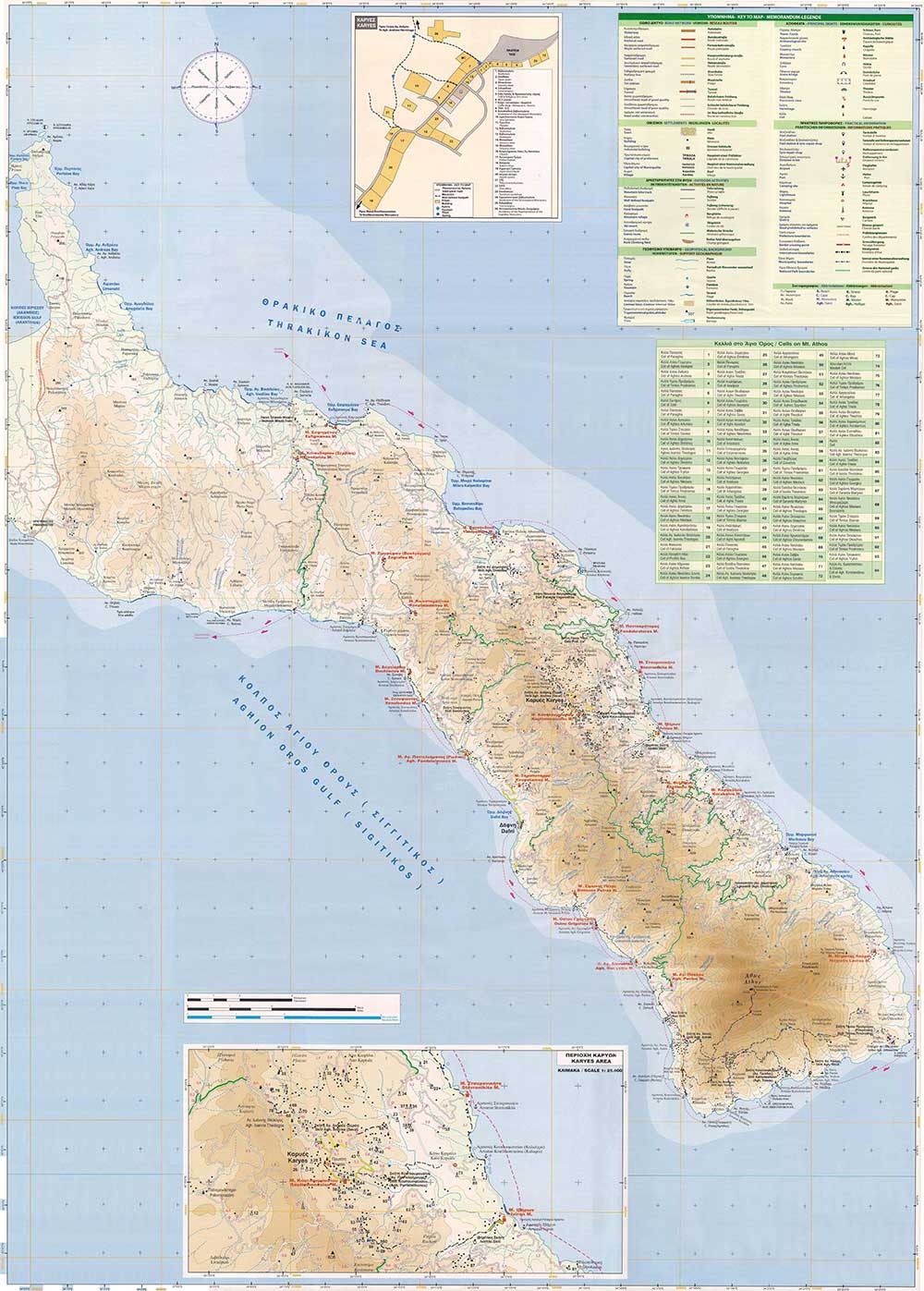|
"Mt. Athos is an empire bereft of an emperor, SAINT NICHOLAS OF OHRID AND ŽIČA
MT. ATHOS
Mt. Athos, a unique monastic state, the third "finger" of the Khalkidhiki peninsula. The heart of world’s Orthodoxy, the last remaining icon of the forgotten Byzantine Empire and the largest temple in the world. Mt. Athos is the sole state in the world where there are no recorded births, only deaths. This wonderful country, with a thousand year long history of silence and prayer, is a refuge for Athonites wishing to die for this world and become reborn in Christ. A mountainous region, covered in dense forests and cleaved with gorges, occasionally tame, ruthless at times, splashed by the clear emerald waters of the Aegean sea. Legend has it that Our Lady resides on Mt. Athos, which rises 2033 meters above sea level and soars into the clouds. In ancient times, Mt. Athos was called Apolloniade, with Zeus's temple situated on its top. Legend has it that Our Lady, having received Holy Spirit's blessing, travelled to Cyprus and encountered a storm, forcing her to disembark on Mt. Athos shores. The polytheists accepted Our Lady, listened to her sermon and made the sign of the cross. This is when Our Lady worked many wonders here. Before continuing her journey, she declared one of the apostles teacher and guardian. From that moment on, Mt. Athos became known as Our Lady's garden. Mt. Athos was under Christian-persecuting Roman governance until 313, when Constantine the Great issued the Edict of Milan, granting civil rights and full religious freedom to the Christians. The monastic community of Mt. Athos had already expanded prior to 313. The first monasteries had already been constructed. In 442, the so-called "Avato" was enforced, forbidding women from accessing Mt. Athos. Thedosius the Great's daughter, princess Placidia, visited Vatopedi monastery, but at one point, Our Lady's icon ordered her to back off. This law is in effect at the present moment and it was breached several times during the tumultuous history of Mt. Athos. At times, certain women tried to sneak into the forbidden grounds. In the 9th century, Athonite monks were granted self-government by a royal charter and their numbers rapidly grew. Today, there are 20 great Mt. Athos monasteries, 12 sketes, numerous cells and monk dwellings, with cliffs inhabited by hermits. 17 monasteries belong to the Greek monastic community: Great Lavra, Vatopedi, Iviron, Dionysiou, Grigoriu, Aghiou Pavlou, Xiropotamou, Xenophontos, Koutloumousiou, Pantokratoros, Filotheou, Karakalou, Dochiariou, Esphigmenou, Simonopetra, Stavronikita and Konstamonitou. These include the Serbian monastery Hilandar, the Russian Panteleimon and Bulgarian Zografou. Karyes is a medieval town at the heart of Mt. Athos. This unique capital of Mt. Athos is the seat of the Holy Council, headed by the Protos. Karyes also includes the konaki of all Mt. Athos monasteries. Mt. Athos is visited daily by numerous pilgrims, Orthodox Christians and many kind-hearted people. While planning a trip to this monastic republic, you must have in mind that Athos is not a tourist venue. Monasteries are not hotels and it's essential to obey the order and rules at the home of those who chose the monastic life, all the while respecting their hospitality as one of the greatest Christian virtues. When visiting Mt. Athos, it is important to plan in advance. Your visiting date must be approved by the Athos Pilgrim Office in Thessaloniki. During mealtime, a praying atmosphere dominates in the refectory. Small talk is not welcome and at sunset, everyone retreats to their cell silently. Mt. Athos customs don't allow short trousers or short-sleeved shirts. Cameras aren't allowed too. You can take pictures of monks or churchyards only with their blessing (approval). You should bear in mind that monks are neither tourist attractions nor tour guides and they should be spared off unnecessary disturbances. It's worth mentioning that ships sail exclusively in the morning. For daily group visits, you need to book a special boat (which is fairly expensive) in agreement with the port officials. Women can get onto boats circling Athos during daytime, sailing 500 meters away from the coastline. This is highly recommended for women during the summer, since they are forbidden from accessing Mt. Athos. All the monasteries are visible from the sea,
Women can visit certain metochas (monastery property outside its grounds), Each visit to Mt. Athos is different and inspires you to return. Almost anyone who visited it once will return again. St. Sava's well in Hilandar was dug by St. Sava himself, according to legend. Anyone who drinks its water will return to Mt. Athos. Visiting Mt. Athos is particularly significant to Serbian people. This is where they get acquainted with the most important aspects of our cultural and historical heritage. Since the tragic fire accident, the monastery's living conditions have worsened
The 20 monasteries are split into 5 groups, each of them consisting of 4 monasteries. The groups have the following structure: The first group consists of Great Lavra, Dochiariou, Xenophontos and Esphigmenou. The third group comprises Iviron, Pantokratoros, Filotheou and Simonopetra. The fourth group includes Hilandar, Xiropotamou, Aghiou Pavlou and Grigoriou. The fifth group comprises Dionysiou, Zografou, Panteleimon and Konstamonitou.
|


